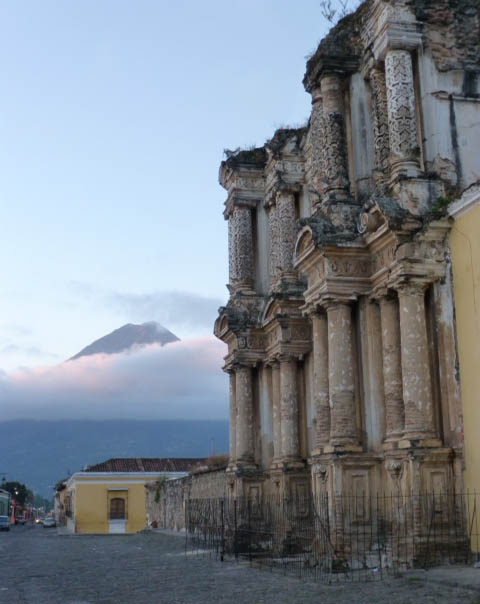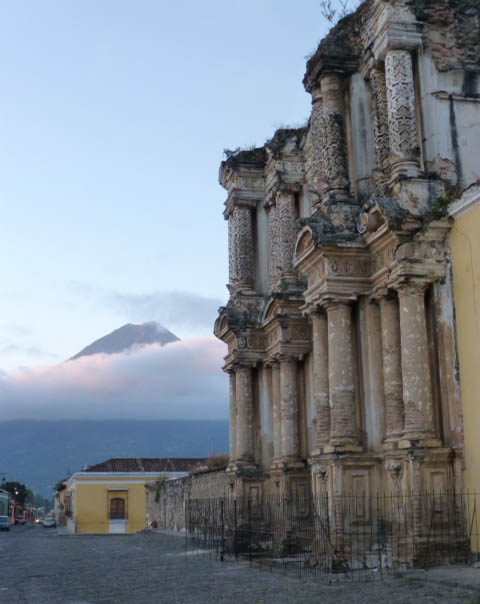Shot in Quijel Quiche Guatemala 22MAY14 Diane Dreyfus
Category: Antigua
Weekly Photo Challenge: One
One Ruin and One volcano = too faboo.
 more FOTOS
more FOTOS
Weekly Photo Challenge: Masterpiece
Beyond divine Shrimp Curry on a bead of risotto snuggling into a Portabello…
lunch @

EPICURE Antigua, Guatemala
Panajachel NGOs seek “organic” unification with Guatemala Non-Profit Network
Judy Sadlier of the Guatemala Non-Profit Network (GNN) was pleasantly overwhelmed by turnout for their introductory meeting. The organizer from Antigua welcomed more than thirty five people representing a score of NGOs and not for profits from around Lake Atitlan. Collectively, her audience reaches way out beyond the impoverished and illiterate Department of Solola. Some of these people are designing their work to be scale-able and build it to roll throughout Guatemala and beyond. Others have more focused and comparatively, modest ambitions.
During the introductions, it would become apparent that these organizations are creatively addressing chronic concerns around health and education. For example, they are introducing micro-finance, micro-consignment, women’s empowerment, mobile libraries, vocational trainings, environmental stewardship, animal health, violence prevention and security. As exhaustive as their array of offerings is, still more impressive is the tens of thousands of people served by this handful. But, this powerful and dedicated audience came in with plenty of skepticism. After all, collaborations have been proposed before. And, nobody was particularly cheered because Ms. Sadlier’s Facebook page revealed that “… some call (her) Queen of the NGOs..” On the other hand, they were happy to learn that she earned her crown by establishing and growing the First (Guatemalan) Women’s Network in 1975.
She began her short remarks by enthusing that there are an equal number of local groups willing to participate but that they were unable to attend this meeting.
“We are going to explore the idea of bringing everyone together,” she began. And speaking from experience, she added, “The process must be ‘organic.’”
“In 2005-6 NGOs were not talking together and there was no publicity about them. So, we developed the Community Forum in Antigua to network opportunities and, from a meeting like this one, the idea of the GNN began. This Network schedules a series of presentations to be followed by a meeting. GNN produced a special event showcasing ten participants in order to raise awareness of their work within their communities and, secondarily, to raise funds. We now have a site, http://www.guatemala-ngos.net, with 75 members posting their profiles, job opportunities and events.”
The size of the crowd drove the meeting. The short but numerous introductions would make it necessary to forgo any agenda and cut right to a 20 minute brainstorming session. This part was peppered with good ideas and invitations. Someone advocated for sharing training instructors and materials; another person promoted exploring themes of best practices for small groups. Could we combine to find ways make a wider impact? Get on the radio? Develop volunteers? Share medicines? Actually collaborate this time?
When all was said, the demographics revealed only one Mayan founded organization; the rest were founded by North American and European women. That is: the most glaringly absent were representatives from the big name NGOs. Players like Habitat for Humanity, Nature Conservancy and the European NGOs that have greater access to government connections and the deepest pockets did not attend this meeting. Is it that they do not want to network or need to cooperate?
Setting up some kind of umbrella group for coordination and communications among NGOs is excellent and there are structural barriers. Beyond the obvious distinctions of capitalization, there are two general classes of missions: those that promote culture and tourism and those that support health and welfare. All incorporate with restrictive “mission statements” to enable them to solicit grants and donors. So, expanding beyond the stated scope and scale to, say, share resources might be minor charter violation or it could be tantamount to fraud.
The task before the organizers is massive. They need some sweetener such as the ultimate ability to connect to something the members could not access alone – like NetHope.org’s shared technologies In any case, they must define common ground, attract a credible percentage of the groups and develop a unifying theme before the next disaster.
Antigua Easter

All over Guatemala, Semana Santa is famous for Easter carpets and wild Catholic displays mixed with not too subtle Mayan symbolism. Although I dreaded being passed hand over hand past trinkets and sausage carts like feasts in NYC, I agreed to a visit to the most famous festival in Antigua. And besides going to the old Capital includes the extremely welcome prospect of eating something besides Tipica or bar food.
The kicker on this adventure would be staying at “Auberge de Burrito,” a hotbed of do-gooders hosted by Romelle. The place is reserved for volunteers and activists en route to/from the highlands to help. Here, we would meet two midwives and a weaver. The Auberge partially supports Romelle’s work of financing post secondary educations. The walls were full of graduates smiling over captions like: Dentist, Teacher, Lawyer, Social Worker. For our purposes, the place was cozy, safe and very close to a parade route and food.
Wednesday evening we saw the first march – the band struck up as thrilling as Broadway and the giant floats approached in a haze of incense. We had been told to stay on the left side of the floats to be on the “right side” of Jesus for good photos. And the other important fact was that the townspeople paid their churches 50Q a block to carry the floats and extra for corners. The money went to hiring the bands and actors to play Judas and Pilot. The males wear purple, black or white hooded garments and the women wear mantillas, black skirts and white blouses.

The floats can have as many as one hundred spaces and bystanders marveled at the precision of the bearers as they swapped in and out. The marches would go on for 15-20 hours. At dawn a mother pointed out her son who had just stepped into the procession from the Merced.
The heavy burdens sway precariously and, so, the pilgrims are assisted by front an back stabilizers and a crew of people, who lift overhead wires out of the way. Some of the bearers close their eyes – perhaps in agony, in the case of the men, they seemed to be staining to pick up the game on their earbuds.
The carpets were of two types the Natural and the Formal. The Natural were made of pine fond foundations, could assume any shape and were adorned with floral details, rosettes and boarders; whereas, the Formal were framed designs laid on with multicolored sawdust applied with stencils. Government buildings and hotels installed very fancy carpets sometimes they would have miniature scenes tucked into the motif. On the route, parades would gingerly pass astride the carpets — leaving the Christ float to destroy them. According to Elizabeth Bell, the Mayans aligned with the idea of Christ’s “human sacrifice” and can be seen making the Mayan “sign of the cross.” as they march behind with the right arm erect crossed by a stationary left.
The drizzle would muffle the incense and cause Joan to speculate about the necessity of an extra Station of the Cross: Jesus is Covered in Plastic.
Joan is an arch foodie and she made only one bad call -and that for political reasons-but the rest was blissful. My favorite meal besides two days of great morning eggs and the fabulous finale dinner was afternoon pork Pupupsas accompanied by a tart coleslaw and the other dish, Chicken Mushroom Crepe were washed down with snifters of Ron Zacapa Centenario. The big yummy was a dinner shared with the midwives, one of whom knew of Hector before the New York Times review him on 15APR11. We reached this oasis of wine and food expecting to wait for an eternity. But, our new friends had a table and hors d’ouvres and the place to themselves when we arrived – to order a ration of portabello and decent Malbec. They would split a steamed fish and I would order a Boeuf Bourguignon and Joan would get the famous duck atop a screamingly fabulous potato pie. We finished dinner sharing a ginger creme brulee and a drop of rum.
I returned to Pana in the rain and fought my way through the drunks to my tower.


